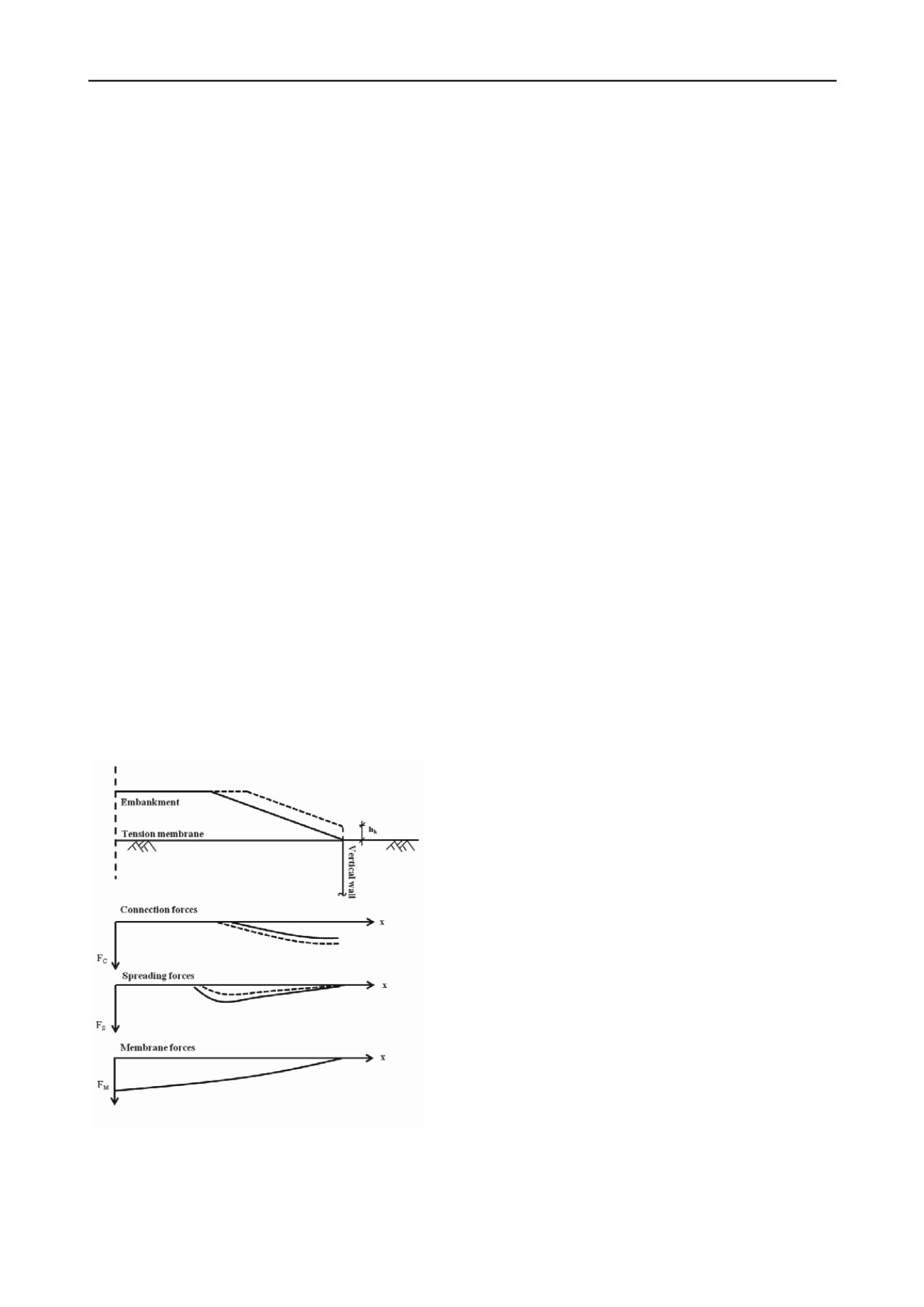
909
Technical Committee 104 /
Comité technique 104
many factors e.g. the distance between the vertical walls, their
length and degree of fixation, the weight of the embankment,
the thickness, stiffness and shear strength of the soft soil, the
stiffness of the vertical walls and tension membrane and the
rel
is as mentioned before time and deformation
de
earth pressure is acting, which
rep
ry
be
ign of the vertical walls shall be done
for
ent origins of tensile
educe but at the same time the
brane and therefore to tensile forces within the
me
and reaches
its
to squeeze out but is hindered by the walls and
the
n the membrane and may
lead to some increased deformation.
3.3.
bration of the numerical model measurement
dat
ität in Bochum, Germany (Jessberger and Güttler,
1988).
sile stiffness of the horizontal
e
determined by derivation of the bending
used for the validation and
calibration of the numerical model.
ts can be
ation of the latter between each other.
A key factor for the design of the system is the knowledge of
the earth pressure distribution along the sheet pile walls. This
distribution
pendent.
Due to the low permeability of mostly saturated soft soils the
total surcharge load from the embankment during and directly
after construction is carried by the pore water pressure. At this
moment and under assumed oedometric conditions the
additional horizontal pressure equals the vertical pressure from
the surcharge, which represents the upper limit regarding the
horizontal loading on the vertical elements. With progressing
consolidation the additional horizontal pressure decreases until
the effective horizontal
resents a lower limit.
Since the self-regulating system is not infinitly rigid and the
loading is not uniform but trapezoidal (Figure 3) the horizontal
earth pressure will be in between these two limits at the ve
ginning and will decrease with time during consolidation.
Due to the deformation of the walls the earth pressure
outside the walls will change from the at rest condition to
passive earth pressure. Similarly inside the walls the earth
pressure will change towards the active earth pressure. It has to
be analyzed to which degree the passive and active earth
pressure will be activated and how this is influenced by the
length and bending stiffness of the vertical elements, the tensile
stiffness of the membrane and the relation of the latter between
each other. The above described behaviour leads to the
conclusion that the maximum bending moment does occur
immediately after the construction of the embankment when the
total surcharge load from the embankment is carried by the pore
water. This means the des
undrained conditions.
The tensile forces in the tension membrane do also depend
on time and deformation. Three differ
forces have to be considered (Figure 4).
Figure 4: Acting forces in the tensile membrane (qualitative sketch)
Connection forces:
Due to the outward movements of the
vertical walls a tensile force is developed within the tension
membrane.
Spreading forces:
Due to the imbalance of the earth
pressure in the region of the embankment shoulders spreading
forces are generated. These spreading forces are mainly
captured by the geotextile. In case of the installation of the
sheet pile walls with an excess length (h
k
> 0) above the ground
level the spreading forces r
connection forces increase.
Membrane forces:
The settlements of the soft soil due to the
embankment weight leads to a geometrical elongation of the
tension mem
mbrane.
For the tension membrane the connection force activated by
the wall movements will be at its maximum during and
immediately after construction of the embankment. The
membrane force will increase during consolidation
maximum when consolidation comes to an end.
Possibly a further influence on the tensile forces is the heave
which can occur in the region of the embankment shoulder
when soil tends
membrane.
The different mechanisms are all interacting and increase or
reduce the total tensile force in the membrane. Furthermore the
creep of the tension membrane has to be taken into account,
which will lead to reduced stresses i
System analysis
Due to the complex and time dependent interaction and the
multitude of influencing parameters a comprehensive numerical
parametric study is planned for the system analysis. For the
validation and cali
a is required.
A real scale field test would generate the most reasonable
data but boundary conditions are hard to control and
consolidation takes a long time, which means the
reproducibility of the tests would be very low. Small scale tests
overcome these drawbacks, but they do not represent the
realistic stress fields of the system. The centrifuge technique
combines the advantage from field and small scale tests.
Realistic stress fields can be generated, boundary conditions are
well controlled and consolidation takes considerably less time
due to the shorter drainage path. Due to these reasons the
system is analyzed in the beam centrifuge Z1 at the Ruhr-
Univers
3.3.1.
Centrifuge tests
By means of centrifuge tests the earth pressure distribution
under varying relations between the bending stiffness of the
vertical walls and the ten
m mbrane will be analyzed.
Therefore the vertical model walls are instrumented with
strain gauges and measurements are taken frequently during the
staged construction of the embankment and consolidation
phases. The measurement data can be transferred into bending
moments by conversion factors. The total earth pressure
distribution can then be
moment distribution.
A detailed description of the centrifuge test set-up and
execution can be found in Detert et al. (2012). The results of
the centrifuge tests are analyzed and
3.3.2.
Numerical parameter study
Numerical methods are a powerful tool in analyzing complex
mechanism with varying parameters. The right choice of the soil
model is very important for the numerical simulation. The soil
model has to be capable of reproducing the significant soil
mechanical processes occurring in the system as well as the load
history of the construction steps and the centrifuge test
procedure. The data obtained from the centrifuge tes
used to confirm the choice of the right soil model.


